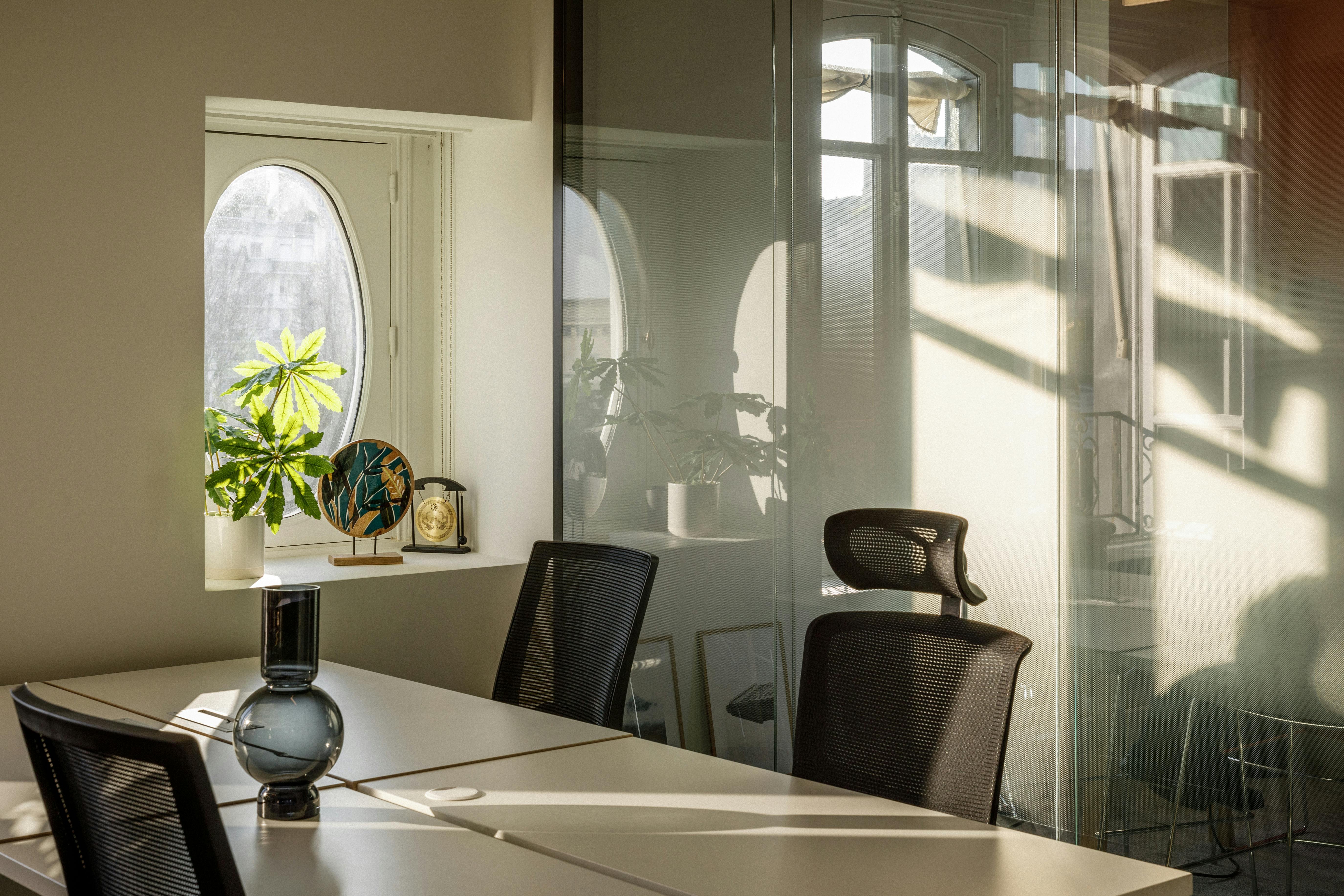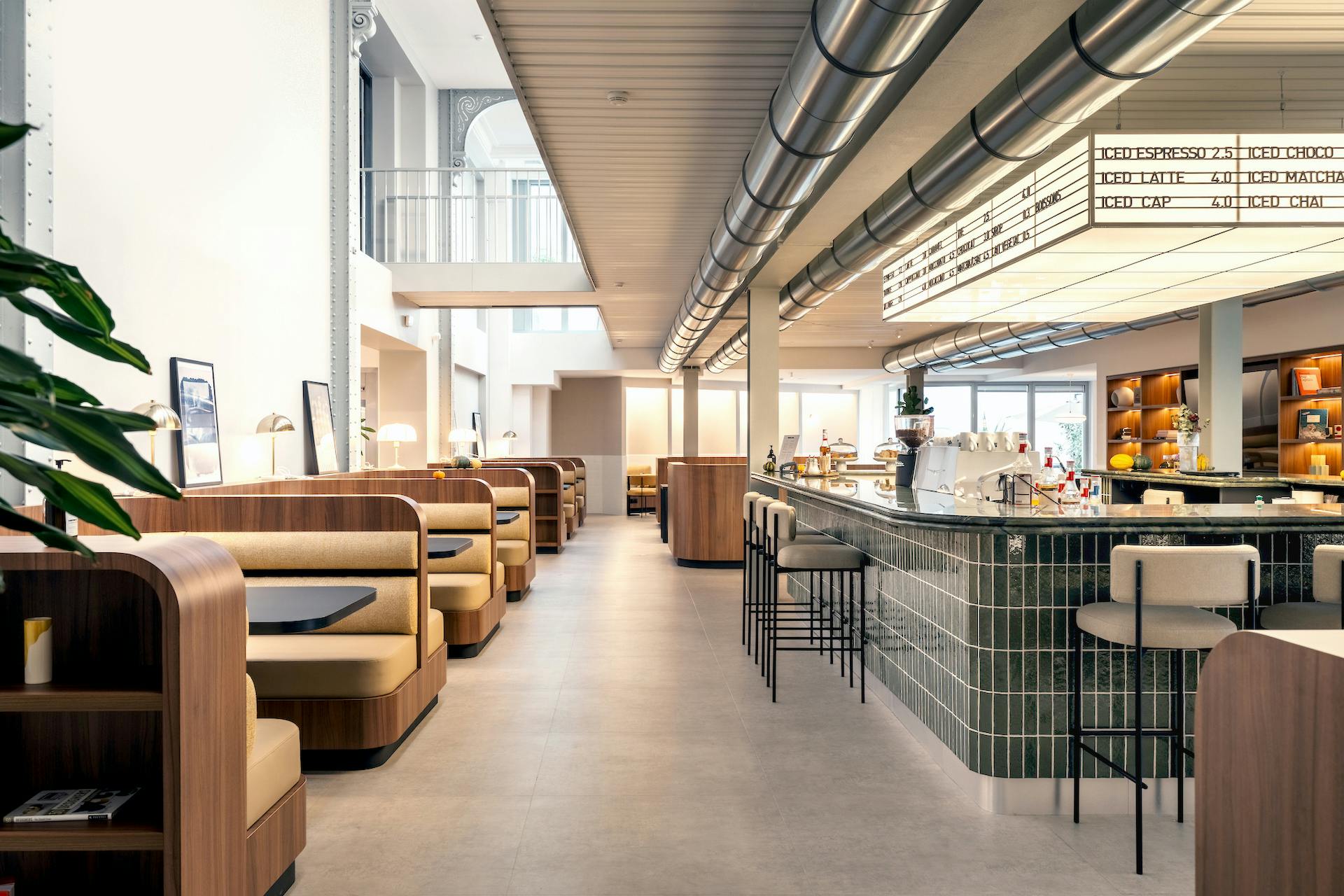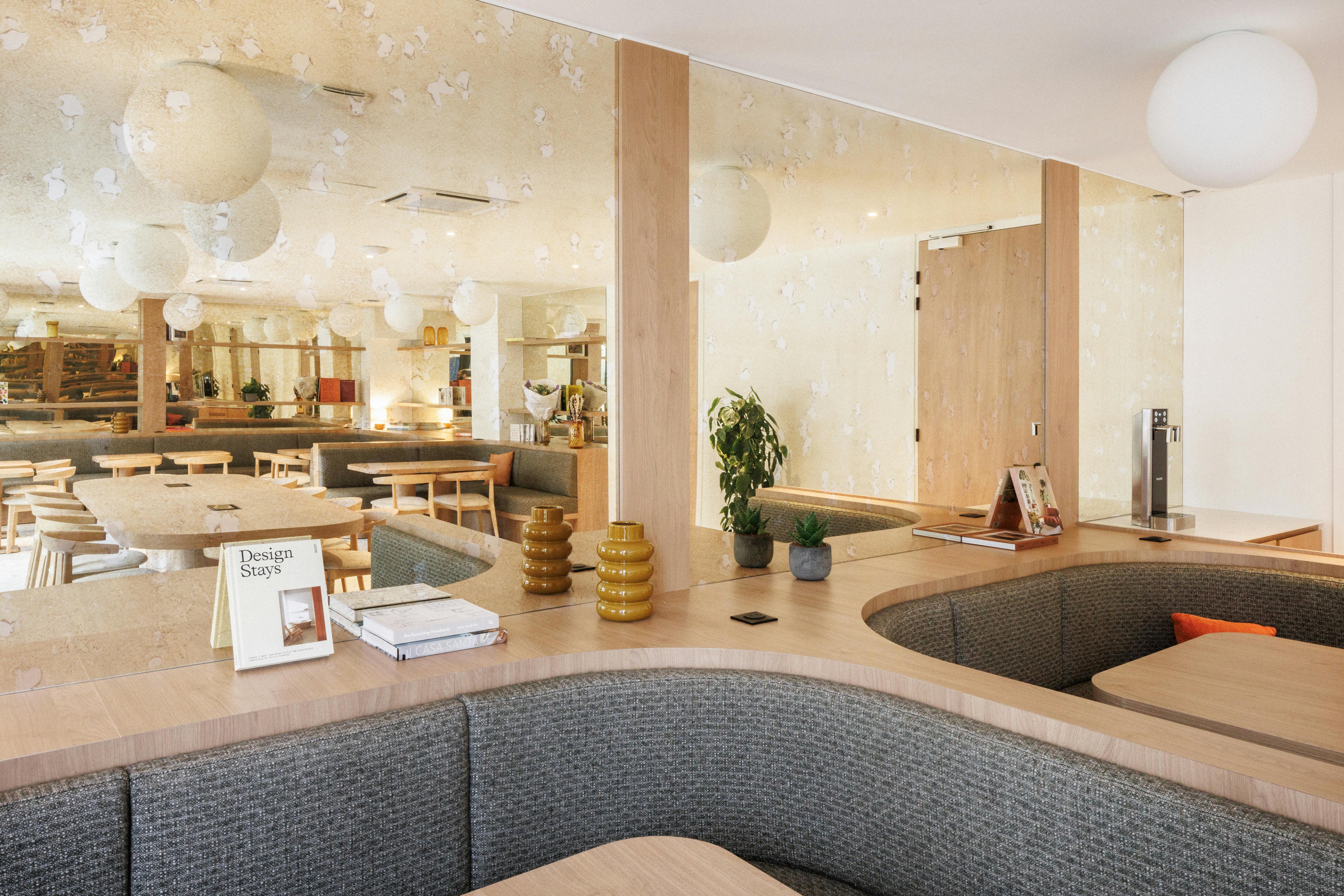

Nomad office: trend or future of the workstation?
Facing new forms of work organization, the nomadic office is redefining professional habits. Between flexible spaces, remote work, and collaboration needs, this solution is emerging as a strong alternative to traditional offices.
In this article, Deskeo, a leader in office leasing and design, reveals why the nomadic office might represent the future of workspaces. Join us on this journey!
What is a nomadic office?
A nomadic office refers to a flexible workspace that allows users—whether freelancers, remote workers, or startup employees—to choose where and how they work. Unlike a fixed workstation in a private office, the nomadic office offers the possibility to work in flexible office spaces, meeting rooms, or even third places like satellite offices or business centers.
As experts in professional office leasing, we observe that this model appeals to both startups and large corporations. Companies benefit from agile solutions, while employees enjoy a work organization better suited to their daily lives.
This vision is perfectly embodied by Hopper, a collection of workspaces designed by Deskeo to combine flexibility, hospitality, and well-being.
Hopper by Deskeo: A new approach to the nomadic office
With Hopper, Deskeo reinvents the work experience by focusing on three fundamental pillars:
- Flexibility: Hybrid workspaces to meet diverse needs.
- Hospitality: Welcoming spaces with every detail designed for comfort.
- Lifestyle: Spaces that integrate work into a modern way of life, with an elegant and convivial atmosphere.
La Casa Deskeo, the first address of this collection, fully embodies this vision. With its barista, collaborative spaces, and fully equipped meeting rooms, it offers an environment that exceeds the expectations of traditional offices.
The benefits of the nomadic office
The nomadic office is increasingly popular for its ability to meet the diverse needs of companies and professionals. By combining flexibility, resource optimization, and a stimulating environment, it stands out as a modern and pragmatic solution.
Space and use flexibility
The nomadic office provides unmatched flexibility with options like rentable desks or nomadic workstations. These solutions allow users to book a desk for half a day, a few days, or even regularly with dedicated workspaces.
This is exactly what Hopper by Deskeo offers, with its adjustable credit system. This flexibility caters to nomadic workers who often switch between different work locations. It is also ideal for companies needing to adjust resources for specific projects, events, or peak periods.
Spaces tailored to every need
The rise of the nomadic office reflects a profound societal shift. Professionals, whether employees or freelancers, increasingly seek flexibility and freedom in their work approach. The traditional fixed office model, often rigid and disconnected from modern expectations, is giving way to more agile solutions.
The nomadic office lets employees choose workspaces tailored to specific moments: a meeting room for team projects, a desk for focused tasks, or a collaborative area to encourage exchanges. This ability to personalize the environment according to needs fosters autonomy and satisfaction, both crucial for attracting and retaining talent.
Cost savings for businesse
For companies, the nomadic office addresses strategic challenges. Fixed office spaces, often underutilized, can be a significant budget burden. By opting for flexible spaces like those offered by Hopper by Deskeo, businesses can reduce costs while adapting to a hybrid organization mixing onsite and remote work.
This model also provides valuable agility: growing or transforming companies can adjust their real estate footprint as needed, without being tied to rigid commercial leases.
An environment conducive to innovation
Collaborative spaces play a central role in fostering creativity and synergy. By bringing together professionals from various sectors in one place, they encourage idea exchanges, informal meetings, and collaboration opportunities.
These environments are particularly popular with freelancers, project creators, and startups looking to expand their networks while enjoying a stimulating setting.
The challenges of the nomadic office
While the nomadic office offers numerous advantages, it is not without challenges. Companies and professionals must adapt to maximize the benefits while overcoming obstacles tied to this new way of working.
Maintaining social ties and team cohesion
One of the main challenges of the nomadic office lies in managing social connections. Mobility, while advantageous, can isolate employees. Working in satellite offices or remotely makes it harder to maintain team cohesion.
To counter this isolation, companies must rethink their management practices and encourage moments of exchange. Initiatives such as regular meetings in modern meeting rooms or collaborative work sessions in convivial spaces like La Casa Deskeo can help. These moments strengthen the sense of belonging and create collaboration opportunities.
In addition, social spaces like cafeterias or outdoor terraces play a vital role in fostering informal interactions, which often drive creativity and strengthen bonds among colleagues.
Equipping spaces with the right tools
The nomadic office requires modern infrastructure to ensure a functional and productive work environment. This includes:
- High-speed internet for video conferencing and access to online tools.
- Connected printers for occasional documentation needs.
- Ergonomic furniture, essential for employee comfort and health.
- Specific equipment like phone booths for confidential calls or fully equipped meeting rooms for team presentations.
Ensuring smooth organization
The success of the nomadic office relies on efficiently managing available spaces. Balancing shared desks, scheduling meeting rooms, and maintaining harmony between open spaces and private offices require meticulous planning.
Furthermore, flexibility demands foresight. Companies must anticipate team needs, whether it's a day-use desk, a collaborative space for a specific project, or an isolated workstation for focused tasks.
Facing new forms of work organization, the nomadic office is redefining professional habits. Between flexible spaces, remote work, and collaboration needs, this solution is emerging as a strong alternative to traditional offices.
In this article, Deskeo, a leader in office leasing and design, reveals why the nomadic office might represent the future of workspaces. Join us on this journey!
What is a nomadic office?
A nomadic office refers to a flexible workspace that allows users—whether freelancers, remote workers, or startup employees—to choose where and how they work. Unlike a fixed workstation in a private office, the nomadic office offers the possibility to work in flexible office spaces, meeting rooms, or even third places like satellite offices or business centers.
As experts in professional office leasing, we observe that this model appeals to both startups and large corporations. Companies benefit from agile solutions, while employees enjoy a work organization better suited to their daily lives.
This vision is perfectly embodied by Hopper, a collection of workspaces designed by Deskeo to combine flexibility, hospitality, and well-being.
Hopper by Deskeo: A new approach to the nomadic office
With Hopper, Deskeo reinvents the work experience by focusing on three fundamental pillars:
- Flexibility: Hybrid workspaces to meet diverse needs.
- Hospitality: Welcoming spaces with every detail designed for comfort.
- Lifestyle: Spaces that integrate work into a modern way of life, with an elegant and convivial atmosphere.
La Casa Deskeo, the first address of this collection, fully embodies this vision. With its barista, collaborative spaces, and fully equipped meeting rooms, it offers an environment that exceeds the expectations of traditional offices.
The benefits of the nomadic office
The nomadic office is increasingly popular for its ability to meet the diverse needs of companies and professionals. By combining flexibility, resource optimization, and a stimulating environment, it stands out as a modern and pragmatic solution.
1. Space and use flexibility
The nomadic office provides unmatched flexibility with options like rentable desks or nomadic workstations. These solutions allow users to book a desk for half a day, a few days, or even regularly with dedicated workspaces.
This is exactly what Hopper by Deskeo offers, with its adjustable credit system. This flexibility caters to nomadic workers who often switch between different work locations. It is also ideal for companies needing to adjust resources for specific projects, events, or peak periods.
2. Spaces tailored to every need
The rise of the nomadic office reflects a profound societal shift. Professionals, whether employees or freelancers, increasingly seek flexibility and freedom in their work approach. The traditional fixed office model, often rigid and disconnected from modern expectations, is giving way to more agile solutions.
The nomadic office lets employees choose workspaces tailored to specific moments: a meeting room for team projects, a desk for focused tasks, or a collaborative area to encourage exchanges. This ability to personalize the environment according to needs fosters autonomy and satisfaction, both crucial for attracting and retaining talent.
3. Cost savings for businesses
For companies, the nomadic office addresses strategic challenges. Fixed office spaces, often underutilized, can be a significant budget burden. By opting for flexible spaces like those offered by Hopper by Deskeo, businesses can reduce costs while adapting to a hybrid organization mixing onsite and remote work.
This model also provides valuable agility: growing or transforming companies can adjust their real estate footprint as needed, without being tied to rigid commercial leases.
4. An environment conducive to innovation
Collaborative spaces play a central role in fostering creativity and synergy. By bringing together professionals from various sectors in one place, they encourage idea exchanges, informal meetings, and collaboration opportunities.
These environments are particularly popular with freelancers, project creators, and startups looking to expand their networks while enjoying a stimulating setting.
The challenges of the nomadic office
While the nomadic office offers numerous advantages, it is not without challenges. Companies and professionals must adapt to maximize the benefits while overcoming obstacles tied to this new way of working.
Maintaining social ties and team cohesion
One of the main challenges of the nomadic office lies in managing social connections. Mobility, while advantageous, can isolate employees. Working in satellite offices, coworking spaces, or remotely makes it harder to maintain team cohesion.
To counter this isolation, companies must rethink their management practices and encourage moments of exchange. Initiatives such as regular meetings in modern meeting rooms or collaborative work sessions in convivial spaces like La Casa Deskeo can help. These moments strengthen the sense of belonging and create collaboration opportunities.
In addition, social spaces like cafeterias or outdoor terraces play a vital role in fostering informal interactions, which often drive creativity and strengthen bonds among colleagues.
Equipping spaces with the right tools
The nomadic office requires modern infrastructure to ensure a functional and productive work environment. This includes:
- High-speed internet for video conferencing and access to online tools.
- Connected printers for occasional documentation needs.
- Ergonomic furniture, essential for employee comfort and health.
- Specific equipment like phone booths for confidential calls or fully equipped meeting rooms for team presentations.
Ensuring smooth organization
The success of the nomadic office relies on efficiently managing available spaces. Balancing shared desks, scheduling meeting rooms, and maintaining harmony between open spaces and private offices require meticulous planning.
Furthermore, flexibility demands foresight. Companies must anticipate team needs, whether it's a day-use desk, a collaborative space for a specific project, or an isolated workstation for focused tasks.
Nomadic office: A vision rooted in the future
While the nomadic office initially emerged as an immediate response to crises like the pandemic, its widespread adoption shows it addresses deeper structural needs. The pursuit of work-life balance, the desire for flexibility, and the emphasis on inspiring environments are not passing trends.
Beyond immediate needs, the nomadic office represents a lasting transformation in our relationship with work. It supports the emergence of new professional models, like hybrid work, where flexibility and autonomy play a central role.
Rather than being a fleeting trend, it is becoming a cornerstone of the work environments of tomorrow. Professionals and companies adopting this model are not merely following a trend but actively shaping the sustainable evolution of the workplace.
Ready to make the leap? Discover how the nomadic office, with Hopper by Deskeo, can transform your professional routine... Contact us!

Contact Us
We find your Perfect fit!

